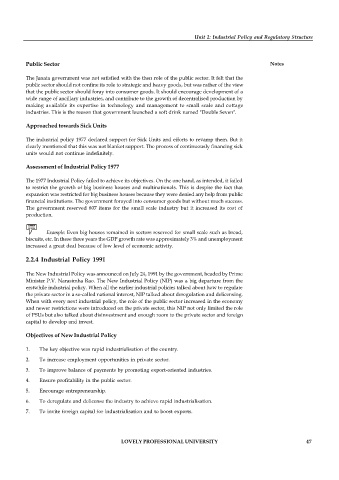Page 54 - DMGT401Business Environment
P. 54
Unit 2: Industrial Policy and Regulatory Structure
Public Sector Notes
The Janata government was not satisfied with the then role of the public sector. It felt that the
public sector should not confine its role to strategic and heavy goods, but was rather of the view
that the public sector should foray into consumer goods. It should encourage development of a
wide range of ancillary industries, and contribute to the growth of decentralised production by
making available its expertise in technology and management to small scale and cottage
industries. This is the reason that government launched a soft drink named "Double Seven".
Approached towards Sick Units
The industrial policy 1977 declared support for Sick Units and efforts to revamp them. But it
clearly mentioned that this was not blanket support. The process of continuously financing sick
units would not continue indefinitely.
Assessment of Industrial Policy 1977
The 1977 Industrial Policy failed to achieve its objectives. On the one hand, as intended, it failed
to restrict the growth of big business houses and multinationals. This is despite the fact that
expansion was restricted for big business houses because they were denied any help from public
financial institutions. The government forayed into consumer goods but without much success.
The government reserved 807 items for the small scale industry but it increased its cost of
production.
Example: Even big houses remained in sectors reserved for small scale such as bread,
biscuits, etc. In these three years the GDP growth rate was approximately 3% and unemployment
increased a great deal because of low level of economic activity.
2.2.4 Industrial Policy 1991
The New Industrial Policy was announced on July 24, 1991 by the government, headed by Prime
Minister P.V. Narasimha Rao. The New Industrial Policy (NIP) was a big departure from the
erstwhile industrial policy. When all the earlier industrial policies talked about how to regulate
the private sector in a so-called national interest, NIP talked about deregulation and delicensing.
When with every next industrial policy, the role of the public sector increased in the economy
and newer restrictions were introduced on the private sector, this NIP not only limited the role
of PSUs but also talked about disinvestment and enough room to the private sector and foreign
capital to develop and invest.
Objectives of New Industrial Policy
1. The key objective was rapid industrialisation of the country.
2. To increase employment opportunities in private sector.
3. To improve balance of payments by promoting export-oriented industries.
4. Ensure profitability in the public sector.
5. Encourage entrepreneurship.
6. To deregulate and delicense the industry to achieve rapid industrialisation.
7. To invite foreign capital for industrialisation and to boost exports.
LOVELY PROFESSIONAL UNIVERSITY 47

